
In this lesson, the Internet is used as a resource for students to access daily (and hourly) information about air quality.
- Subject:
- Applied Science
- Environmental Science
- Material Type:
- Activity/Lab
- Lesson Plan
- Date Added:
- 10/02/2019

In this lesson, the Internet is used as a resource for students to access daily (and hourly) information about air quality.
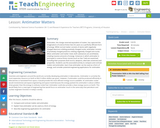
Antimatter, the charge reversed equivalent of matter, has captured the imaginations of science fiction fans for years as a perfectly efficient form of energy. While normal matter consists of atoms with negatively charged electrons orbiting positively charged nuclei, antimatter consists of positively charged positrons orbiting negatively charged anti-nuclei. When antimatter and matter meet, both substances are annihilated, creating massive amounts of energy. Instances in which antimatter is portrayed in science fiction stories (such as Star Trek) are examined, including their purposes (fuel source, weapons, alternate universes) and properties. Students compare and contrast matter and antimatter, learn how antimatter can be used as a form of energy, and consider potential engineering applications for antimatter.

Using scrap metal and spare parts, William Kamkwamba created a windmill to harness the wind and bring electricity and running water to his Malawian village. The resource includes a lesson plan/book card, a design challenge, and copy of a design thinking journal that provide guidance on using the book to inspire students' curiosity for design thinking. Maker Challenge: Develop a way to harness the wind by designing with Strawbees.
A document is included in the resources folder that lists the complete standards-alignment for this book activity.
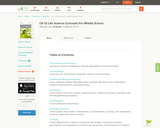
CK-12’s Life Science delivers a full course of study in the life sciences for the middle school student, relating an understanding of the history, disciplines, tools, and modern techniques of science to the exploration of cell biology, molecular biology, genetics, evolution, prokaryotes, protists,fungi, plants, animals, invertebrates, vertebrates, human biology, and ecology. This digital textbook was reviewed for its alignment with California content standards.
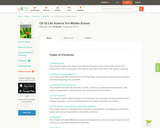
CK-12’s Life Science delivers a full course of study in the life sciences for the middle school student, relating an understanding of the history, disciplines, tools, and modern techniques of science to the exploration of cell biology, genetics, evolution, prokaryotes, protists, fungi, plants, the animal kingdom, the human body, and ecology. This digital textbook was reviewed for its alignment with California content standards.
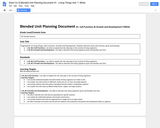
Organization of Living Things: Cells Functions, Growth and Development- Students will learn how cells function, grow and develop.
L.OL.M.2 Cell Function: I am able to explain the role cells play in the survival of living organisms.
L.OL.M.3 Growth and Development: I am able to describe how living organisms grow and develop over time
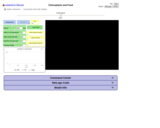
This simulation shows the relationship between the inputs and outputs in the chloroplasts of plants to help explain how they convert water and carbon dioxide to glucose and water with the help of energy absorbed from light. It is used in Lesson 5 of Unit 7.4 in the OpenSciEd curriculum.
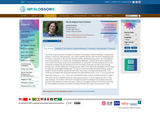
This lesson is about the flow of energy in ecosystems. The setting is Plimoth Plantation, a living history museum in Plymouth, Massachusetts, USA, where students will learn about the first Thanksgiving meal in America, celebrated in 1621 by early American settlers and Wampanoag Indians. By examining this meal and comparing it to a modern day Thanksgiving celebration, students will be able to explore the way in which food energy moves and is transformed in an ecosystem. The learning goals focus on the movement of energy from one feeding level to the next within a food web, the way in which energy changes form, and the inefficiency of energy transfer, which in turn affects the availability of food energy for organisms at the highest feeding level. The lesson is directed at high school level biology students. Students should be familiar already with food webs, food chains, and trophic (feeding) levels. They should also be familiar with the general equations for photosynthesis (CO2 + H2O => C6H12O6) and cell respiration (C6H12O6 => CO2 + H2O), and understand the basic purpose of these processes in nature. This lesson can be completed during one long classroom period, or can be divided over two or more class meetings. The duration of the lesson will depend on prior knowledge of the students and on the amount of time allotted for student discussion. There are no supplies required for this lesson other than the downloadable worksheets (accessed on this BLOSSOMS site), paper and some glue or tape.
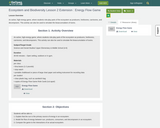
An active, high-energy game, where students role-play parts of the ecosystem as producers, herbivores, carnivores, and decomposers. This activity can also be used to simulate the bioaccumulation of toxins.
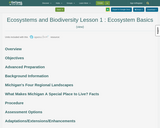
Students first consider what supports all life on Earth
and are then introduced to the levels of environmental
organization (biosphere, biome, ecosystem, community,
population, and organism).
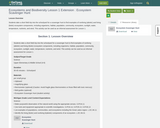
Students take a short field trip into the schoolyard for a scavenger hunt to find examples of nonliving (abiotic) and living (biotic) ecosystem components, including organisms, habitat, population, community, ecosystem, sunlight, water, temperature, nutrients, and wind. This activity can be used as an informal assessment for Lesson 1.
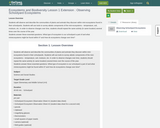
Students will observe and describe the communities of plants and animals they discover within mini-ecosystems found in their schoolyards. Students will use tools to survey abiotic components of the mini-ecosystems – temperature, soil, moisture, etc. In order to observe changes over time, students should repeat the same activity (in same location) several times over the course of the year.Students answer these essential questions: What type of ecosystem is our schoolyard a part of and what miniecosystems might be found within it? and How do ecosystems change over time?
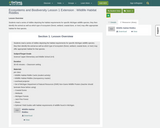
Students read a series of riddles depicting the habitat requirements for specific Michigan wildlife species; they then identify the animal as well as which type of ecosystem (forest, wetland, coastal dune, or river) may offer appropriate habitat for that species.

In this activity students will identify where the ingredients in a tomato and cheese sandwich originated. They will trace a food item from its place as a sandwich ingredient to where it was originally grown. Students then suggest ways that people can minimize their impact on ecosystems and biodiversity by making informed decisions about food choices.
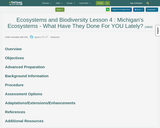
In this activity,students participate in a charades-like activity to learn about some of the secret services provided by ecosystems and the species within them. Later, students apply understanding of the terms ecological, economic, and social to categorize ecosystem benefits. Finally, students review the lesson concepts in a bingo game.

Presentation to teach that we use food as fuel and to introduce the joule.

As a society, we use land in many different ways. The way we use land has a tremendous impact on how water flows over and through land as it makes it way to streams, rivers, and the Great Lakes. When rainwater falls on land, it gradually makes its way downhill. In developed areas, including both farms and urban areas, there is much less vegetation to slow the water down. As a result, the water moves quickly over the surface of the ground, picking up dirt and other materials and carrying it along with the flow of water. This process is known as "erosion." The suspended material, called "sediment," is carried through the watershed to the streams, rivers, and lakes. Success with this lesson will happen when students are able to explore the land use around sample Michigan sites, and use that information to analyze which sites have the highest average sediment levels and which have the lowest.
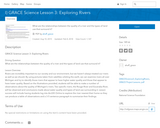
Rivers are incredibly important to our society and our environment, but we haven't always treated our rivers as well as we should. By using pictures taken from satellites orbiting the earth, we can examine rivers all over Michigan and try to identify those rivers that appear to have higher water quality and those that appear to have lower quality. Based on the illustrations provided, students will be able to make a number of observations about the quality of Michigan's rivers. Two specific rivers, the Rouge River and Escanaba River, will be observed and conclusions made about water quality and types of land use surrounding it. Lesson success will include having students log into ArcGIS Online to explore the river nearest their home so they can produce a table of observations and a 3-5 sentence paragraph to summarize their findings.
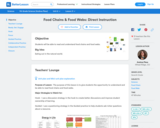
Objective
Students will be able to read and understand food chains and food webs.
Big Idea
Eating out in the natural world.
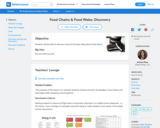
Objective
Students will be able to discover some of the basic ideas about food chains.
Big Idea
You are what you eat.